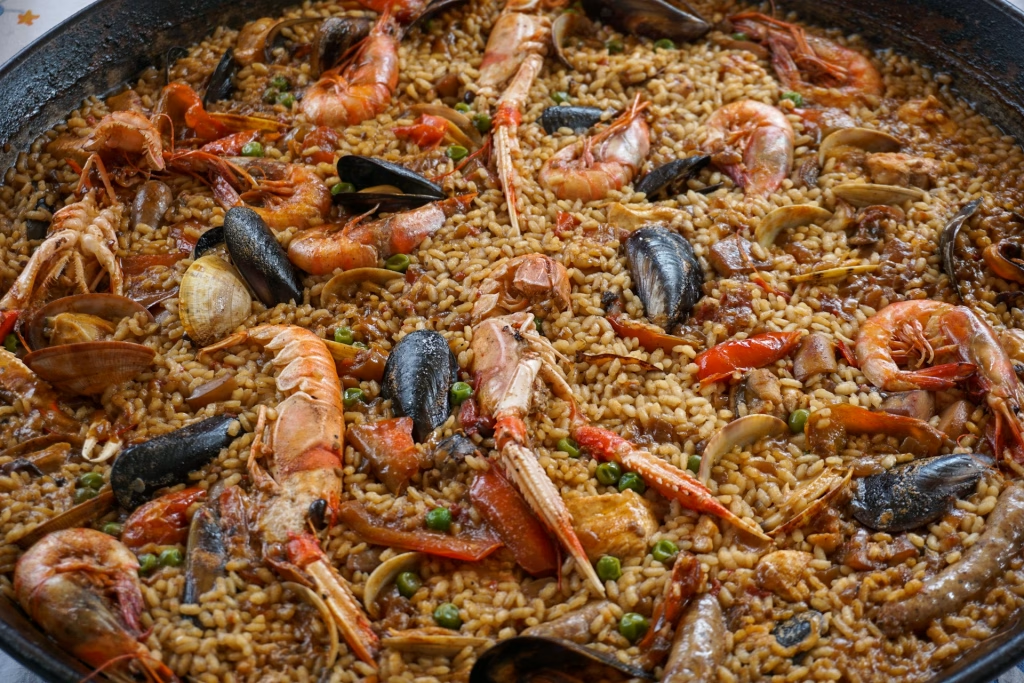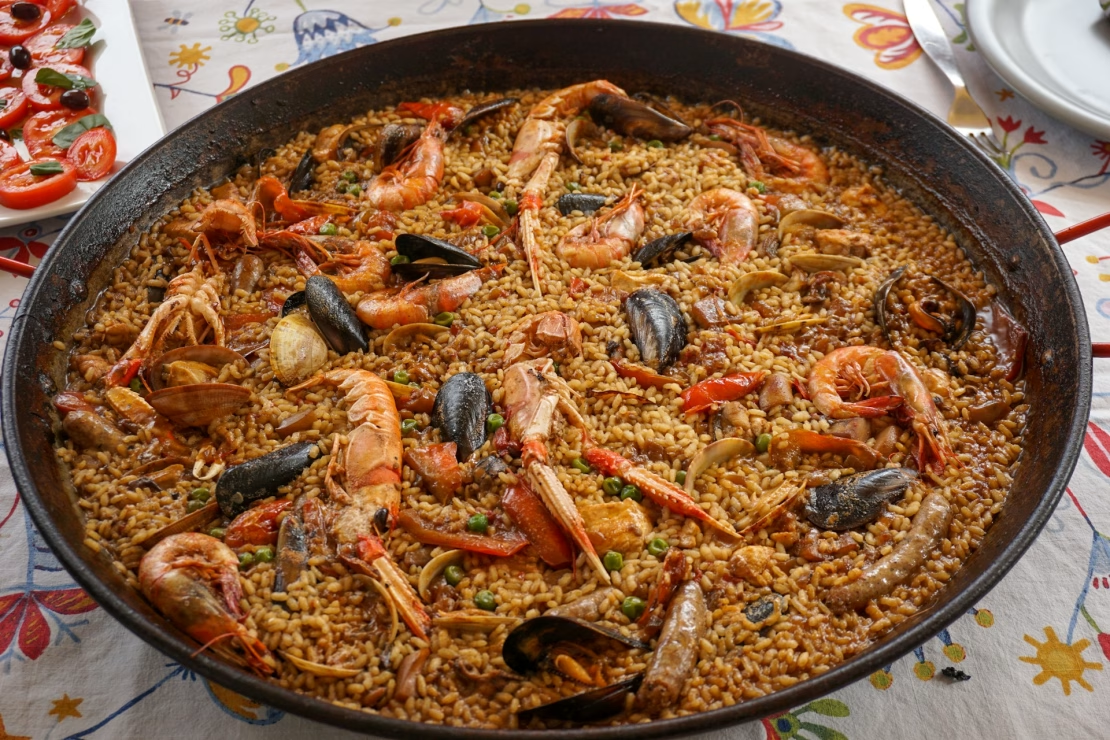Paella with Meat & Seafood (Spain) is one of the most iconic and flavorful dishes in Spanish cuisine, combining land and sea in a harmonious, saffron-scented rice dish.
Originating in the region of Valencia, this version known as Paella Mixta, brings together the savory richness of meats such as chicken and rabbit with the oceanic sweetness of shellfish and fish. While there are many adaptations, the authentic paella with meat and seafood remains a centerpiece in Spanish homes and celebrations.
Whether you’re looking to prepare this dish for a festive gathering or want to experience a taste of Spain in your kitchen, this guide will walk you through every step, from choosing the right ingredients to perfecting the technique.
Table of Contents
Ingredients for Paella with Meat & Seafood (Spain)
Serves 6
Meat & Seafood:
- 400g (14 oz) bone-in chicken thighs or drumsticks, cut into chunks
- 200g (7 oz) rabbit (optional, traditional in Valencia) or pork shoulder, diced
- 200g (7 oz) firm white fish (like monkfish or cod), cut into chunks
- 300g (10.5 oz) raw shrimp or prawns, deveined, shells on
- 300g (10.5 oz) mussels or clams, scrubbed and cleaned
- 200g (7 oz) calamari or squid, cleaned and sliced into rings
Rice and Broth:
- 2 cups Bomba or Calasparra rice (short-grain Spanish rice)
- 1.5 liters (6 cups) fish or chicken broth (preferably homemade)
- 1/2 tsp saffron threads, soaked in 2 tbsp warm water
- 2 tsp smoked paprika (Pimentón de la Vera)
- Salt to taste
- Freshly ground black pepper
Vegetables and Aromatics:
- 1 medium onion, finely chopped
- 1 red bell pepper, diced
- 1 green bell pepper, diced
- 2 ripe tomatoes, grated or finely chopped
- 4 garlic cloves, minced
- 100g (3.5 oz) green beans or flat green beans (judía verde)
- 1/2 cup frozen peas (optional)
Oils and Garnish:
- 1/4 cup extra virgin olive oil
- Lemon wedges for serving
- Fresh parsley, chopped, for garnish
Step-by-Step Instructions
Step 1: Prep the Ingredients
Start by cleaning and cutting all meats and seafood. Peel and devein shrimp, scrub mussels or clams, chop vegetables, and measure spices and rice. Soak saffron threads in warm water for color and aroma infusion.
Step 2: Make the Sofrito
Heat olive oil in a large paella pan over medium heat. Add chopped onions and sauté for 2–3 minutes until soft. Add garlic, red and green bell peppers, and continue sautéing for another 3–4 minutes.
Stir in the grated tomatoes and cook down until the mixture becomes thick and caramelized—about 10–12 minutes. This is your sofrito, the flavor base.
Step 3: Cook the Meat
Add chicken (and rabbit or pork) to the sofrito. Brown the meat on all sides for about 5–7 minutes. Season with salt, pepper, and paprika.
Step 4: Add Seafood in Layers
Push meat to the sides of the pan. Add calamari rings and white fish chunks to the center and sauté for 2–3 minutes. Remove shrimp and mussels from the seafood bowl and set them aside for the final stage.
Step 5: Toast the Rice
Stir the rice into the pan so it mixes evenly with the meat, seafood, and sofrito. Toast the rice for about 2 minutes, letting it absorb the flavors.
Step 6: Add Broth and Saffron
Pour in the warm broth and saffron water. Gently shake the pan to distribute the rice evenly—do not stir beyond this point. Bring to a boil, then reduce to a gentle simmer.
Step 7: Simmer and Add Veggies
After 10 minutes of simmering, add green beans and peas. Let it cook uncovered without stirring. This helps develop the socarrat—the crispy bottom layer of rice that defines a good paella.
Step 8: Add Shellfish
Arrange shrimp and mussels on top of the rice. Press them slightly into the broth. Cover loosely with foil or a lid and cook for another 10–12 minutes until seafood is cooked and mussels open.
Step 9: Rest and Garnish
Remove the pan from heat. Cover with a clean kitchen towel and let it rest for 5–10 minutes. Garnish with parsley and lemon wedges.

Serving Suggestions
- Serve directly from the paella pan at the table for an authentic experience.
- Offer lemon wedges on the side—never squeeze them beforehand.
- Pair with a chilled Spanish white wine like Albariño or a fruity rosé.
- Accompany with a simple green salad or crusty bread to balance the richness.
Tips for the Perfect Paella
- Use the Right Rice: Spanish short-grain rice like Bomba absorbs more liquid without becoming mushy.
- Don’t Stir After Broth Is Added: This allows the rice to cook evenly and creates the desirable socarrat crust.
- Layer Seafood Last: Shrimp and mussels cook quickly; add them toward the end to avoid overcooking.
- Use Real Saffron: It’s expensive but essential for authenticity and flavor depth.
- Even Heat Distribution: Use a wide burner or cook over an open flame to heat the entire paella pan evenly.
Healthier Alternatives
- Low-Sodium Broth: Use homemade unsalted chicken or fish broth to control sodium intake.
- Lean Meats: Use skinless chicken breast instead of thighs, or turkey pieces.
- Vegetarian Option: Replace meat and seafood with chickpeas, artichokes, and mushrooms.
- Whole-Grain Rice: Though not traditional, brown short-grain rice can be used with a longer cooking time.
- Less Oil: Reduce olive oil slightly or use a cooking spray for browning meats.
Creative Variations
- Chorizo Paella: Add slices of Spanish chorizo sausage for a smoky, spicy kick.
- Black Paella (Arroz Negro): Use squid ink to turn the dish black, popular in coastal areas.
- Paella Valenciana: Stick to traditional meats like rabbit and chicken, no seafood.
- Vegan Paella: Use seasonal vegetables, vegetable broth, and plenty of smoked paprika for flavor.
- Cheesy Paella Bake: Top leftovers with grated Manchego or cheddar and bake for a fusion twist.
Common Mistakes to Avoid
- Using Long-Grain Rice: It doesn’t absorb liquid properly and ruins the texture.
- Stirring the Rice: Leads to risotto-like consistency instead of separate, tender grains.
- Too Much Liquid: Makes the dish mushy—always stick to the recommended rice-to-broth ratio.
- Undercooking Shellfish: Ensure mussels open fully and shrimp are pink and opaque.
- Skipping the Resting Time: Resting helps redistribute flavors and finalize the texture.
History of Paella with Meat & Seafood (Spain)
The roots of Paella with Meat & Seafood (Spain) trace back to the Valencia region, where it began as a humble meal of rice and local ingredients cooked over open fires in the countryside. The name “paella” is derived from the Latin word patella, meaning pan, referring to the wide, shallow vessel in which the dish is traditionally prepared.
In the early days, paella was a farmer’s meal, often containing rabbit, snails, and beans cooked with rice in a single pan. As the dish spread to coastal regions, seafood versions emerged. Over time, families began blending land and sea ingredients, giving rise to the Paella Mixta style we know today.
By the 20th century, paella had become Spain’s national dish, symbolizing communal eating and regional pride. Today, whether served during Sunday family gatherings, beachside festivals, or international culinary expos, Paella Mixta remains a testament to Spain’s agricultural and maritime richness.
FAQs about Paella with Meat & Seafood (Spain)
- Can I make paella without a paella pan?
Yes, you can use a wide, shallow skillet or frying pan as long as it distributes heat evenly. - What’s the best rice to use?
Bomba or Calasparra rice is ideal due to its high absorption and ability to stay firm. - Can I prepare paella in advance?
You can prepare the sofrito and pre-cook meats ahead of time, but paella is best served fresh. - What if I can’t find saffron?
You can substitute with turmeric for color, but the unique flavor of saffron will be missing. - Is it necessary to use both meat and seafood?
Not at all—use only meat, only seafood, or even just vegetables if desired. - Why didn’t I get the crispy bottom crust (socarrat)?
Too much stirring or excessive broth can prevent the crust. Let it sit undisturbed during the final simmer. - Can I use frozen seafood?
Yes, but thaw completely and pat dry before adding to the pan to avoid excess water. - How do I know when the rice is done?
It should be al dente—tender but with a slight bite. Taste a grain from the center. - How long should paella rest before serving?
Let it rest for 5–10 minutes, covered with a towel, to settle flavors and textures. - Can I make it spicy?
Traditional paella isn’t spicy, but you can add chili flakes or hot paprika to the sofrito.
Paella with Meat & Seafood (Spain) is more than just a meal, it’s a celebration of Spanish culture, blending rustic and coastal influences into one unforgettable dish. Whether you’re new to cooking or an experienced home chef, mastering paella will bring both pride and pleasure to your table. With its vibrant colors, balanced flavors, and rich heritage, this dish offers an experience that goes far beyond its ingredients.
From the sizzle of the sofrito to the final garnishing of lemon wedges, paella invites community, conversation, and joy. So gather your ingredients, fire up your stove, and bring a little bit of Spain into your home with this authentic and delicious recipe.


